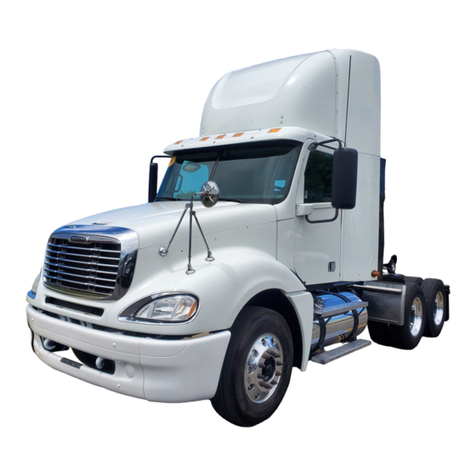
Park Smart System Diagnostic Table
TRUCK MUST BE IN PARKED MODE TO
PERFORM DIAGNOSTIC TESTS!
CORRECTIVEACTION / SEE APPENDIX
Unit Runs - But Does Not
Blow Cold Air
1. Airflow blockage.
2. Compressor Fuse or Relay.
3. Compressor controller
connections.
4. Compressor controller board.
5. High pressure switch
6. Evaporator Sensor/Freeze
switch defective
7. Compressor thermal switch
8. Defective compressor
9. Blend door position.
10. Evaporator blower
11. Loss of charge (refrigerant
system not serviceable).
1. Clear any blockage from recirculation grill or louvers. Also
check condenser inlet and outlet for restriction (under
truck).
2. Check F1 fuse and PARKED MODE LS3 relay. See
appendix F and D
3. Confirm all wire harness plugs are connected.
4. Check Control PCB Assembly. See appendix I
5. Check pressure switch. See appendix E
6. Check freeze switch. See appendix G
7. Check thermal switch. See appendix H
8. Check power to compressor. See appendix I
9. Check blend door operation. See appendix M
10. Check Evaporator blower. See appendix K
11. If all tests check OK a loss of charge may have occurred.
1. Poor electrical connection.
2. Condenser fan inoperative.
3. Air flow blockage causing high
pressure or freeze condition.
1.
Check all electrical connections.
2.Check condenser fan. See appendix J
3.Check for restricted airflow under truck at condenser inlet
and outlet and at louvers and recirculation grill. Check
pressure switch and/or freeze switch. See appendix E and G
Unit Blows Cold Air, But
Low Airflow
1. Check all duct work
connections.
2. Air flow restricted
3. Evaporator Blower motor
inoperative.
1. Make sure all ducts are connected, sealed and secure.
2. Check for airflow at louvers and recirculation grill.
3. Check evaporator blower motor. See appendix K
Unit Runs Correctly, But
Less Than Expected Run
Time
1. Ground terminal(s).
2. AUX batteries weak or not
charged correctly.
3. Separator not functioning
correctly.
4. Trucks main batteries poor
condition
5. High amperage draw
6. Defective Outside air
temperature sensor.
1. Inspect and tighten ALL connections.
2. Check AUX batteries for condition and state of charge.
See appendix A
3. Check separator connections and operation. See
appendix B
4. Check Main truck batteries for condition and state of
charge. See appendix A
5. Use DC ammeter to check amps when running.
Excessive amperage could signal compressor or internal
component issue. Amperage ranges 40A to 75A
depending on conditions
6. Energy management will stop and amp usage will
increase.
7. See appendix O.
Unit is Noisy or Vibrates
1. Evaporator Blower motor.
2. Condenser fan motor.
3. Compressor mounting.
1. Check evaporator blower. See appendix K
2. Check condenser fan. See appendix J
3. Check rubber compressor mounts. See appendix L
Unit runs but does not blow
hot air
1. Heater power and ground
2. Heater fuse
3. Wiring harness
4. Heater enable signal
1. Check for power at the heater pins 1 & 2
2. Check heater fuse F3. See page 5.
3. Check wiring harness connectors and physical condition
4. Check for heater enable 12V at heater pin 7 from control
PCB assy, pin C15
NOTE: Heater diagnostics can be performed using Espar’s EDITH diagnostics lap top based program. You must have the ISO
cable adapter for the ParkSmart Hydronic heater. It is proprietary to Freightliner and other cable adapters will not interchange!




























